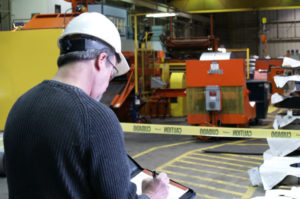Accident or incident investigations are an important procedure following any type of event where a near miss or injury occurred. Two benefits of incident investigations are it leads to finding the root cause of the event, and it also is known to increase employee accountability.
A senior EHS manager from Virginia, JA Rodriguez, did a presentation on worker accountability at ASSE’s Safety conference. He pointed out that there are two types of accountability. One, holding a person accountable. Two, holding yourself accountable. Workers must see that accountability starts at the top. Managers and supervisors must also hold themselves accountable for safety. They must lead their workers and recognize why a person behaved a certain way or what may have been missing in procedures that lead to the incident. Rodriguez points out that the best way to find real root causes is to conduct incident investigations.
Workers should be aware of company policies regarding incident investigations. The persons responsible for performing incident investigations should be trained appropriately.
What is an Incident Investigation?
An incident investigation is conducted to determine the true cause of the incident and make changes that reduce the chances of similar incidents occurring in the future. There are 4 key parts to a successful and effective incident investigation.
1: Respond to the Incident
- Check the scene for hazards.
- Safely control hazards or remove people from the hazards.
- Respond to medical needs: if necessary, call emergency medical services (EMS) and/or provide first aid to the level you are trained.
- Secure the area to prevent further injury or disruption of evidence.
- Contact the appropriate personnel, such as supervisors, management, or emergency responders, after injured parties are medically stable.
- Start preserving evidence that may be needed for the investigation, including photographing or isolating evidence that may not be able to be removed from the scene.
2: Gather Information
- Include management and employees in the investigation.
- Make sure that the investigation team includes or has access to technical expertise in safety, engineering, operations, or any other subjects that might be helpful.

- Focus on finding causes for the issue rather than assigning blame.
- Collect as much data as possible by interviewing personnel involved in the incident (including witnesses) and documenting the entire incident site (i.e., with photographs or video). The more information you have, the easier it will be to see the big picture.
3: Analyze the Data
- Look for root causes. A root cause is a factor that underlies other contributing causes and that could eliminate recurrence of the problem if it is addressed.
- Rather than just focusing on the actions of the people involved in the incident, try to consider the organization as a whole and whether there are any weaknesses in the current procedures that may have contributed to the incident.
- Using multiple methods of data analysis, such as fishbone diagrams or the Why Method, can help uncover root causes that may have been missed using only one.
There are number of different causes. Maybe the employee was not properly trained before performing his or her work tasks. As a result, training records should be well maintained and employees should attend annual safety training.
Read More About Key Benefits of Annual Safety Training
4: Determine Corrective Actions
Once all root causes of the incident have been determined, recommend corrective actions that can help minimize or eliminate the chances of reoccurrence.
- Be specific in your instructions for what each action entails and how it should be implemented.
- Assign responsible parties to ensure that the corrective actions are completed and a time frame for completion.
- Keep your recommendations constructive and objective.
- Clearly point out instances where human error is a cause. Disciplinary actions should be handled by Human Resources.
- Outline a follow-up plan to assure that actions are implemented correctly and work as planned.
Have questions about conducting Accident/Incident Investigations? Contact an SRP Safety Consultant to discuss your company health and safety needs. We have seven convenient locations in Charlotte, Dallas, Denver, Honolulu, Midland, Shreveport and Pittsburgh. Call us toll free at (866) 222-4972 or visit us online.

 ">
">
 ">
">